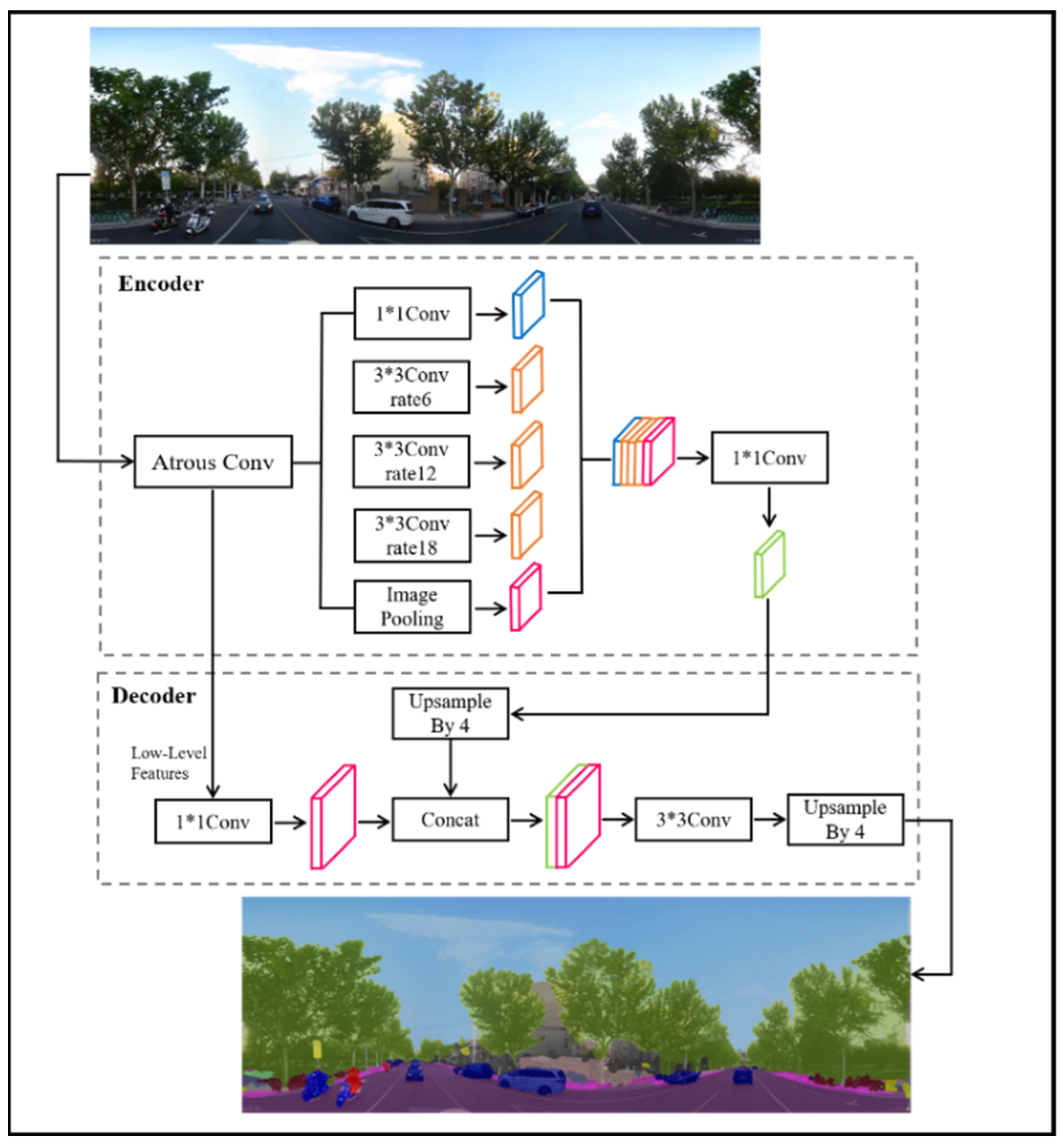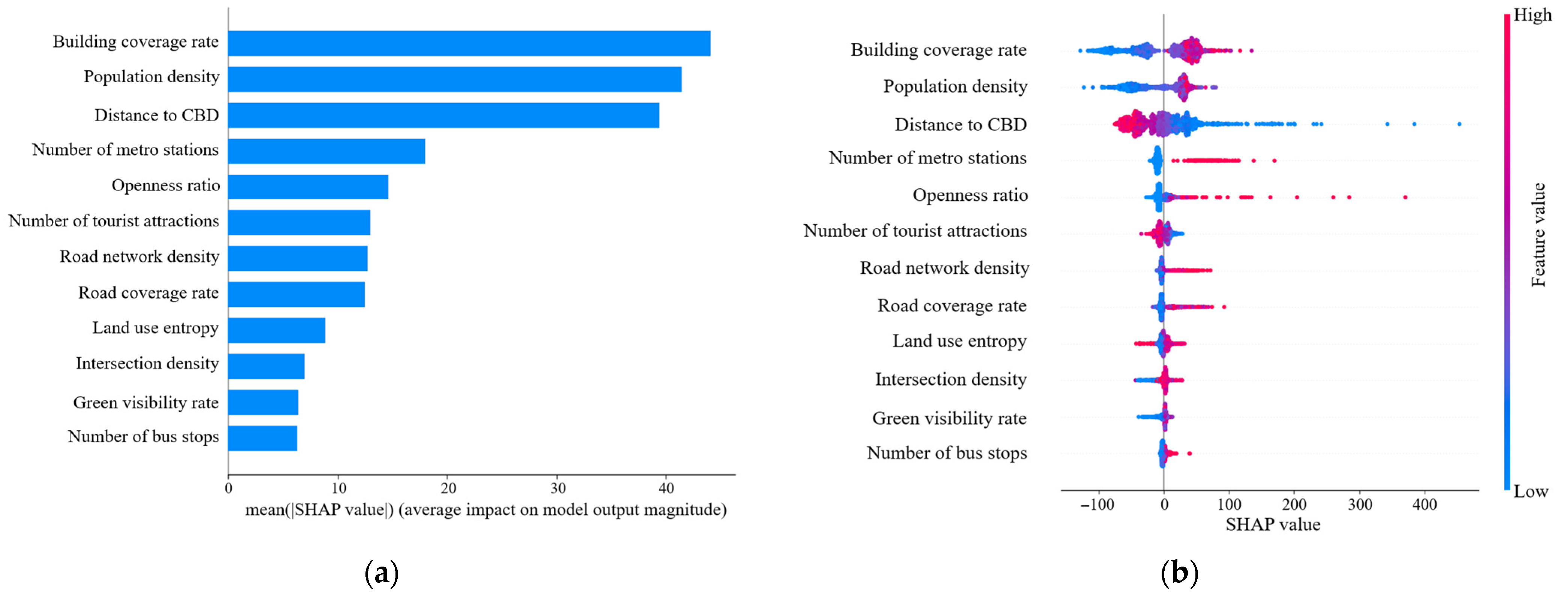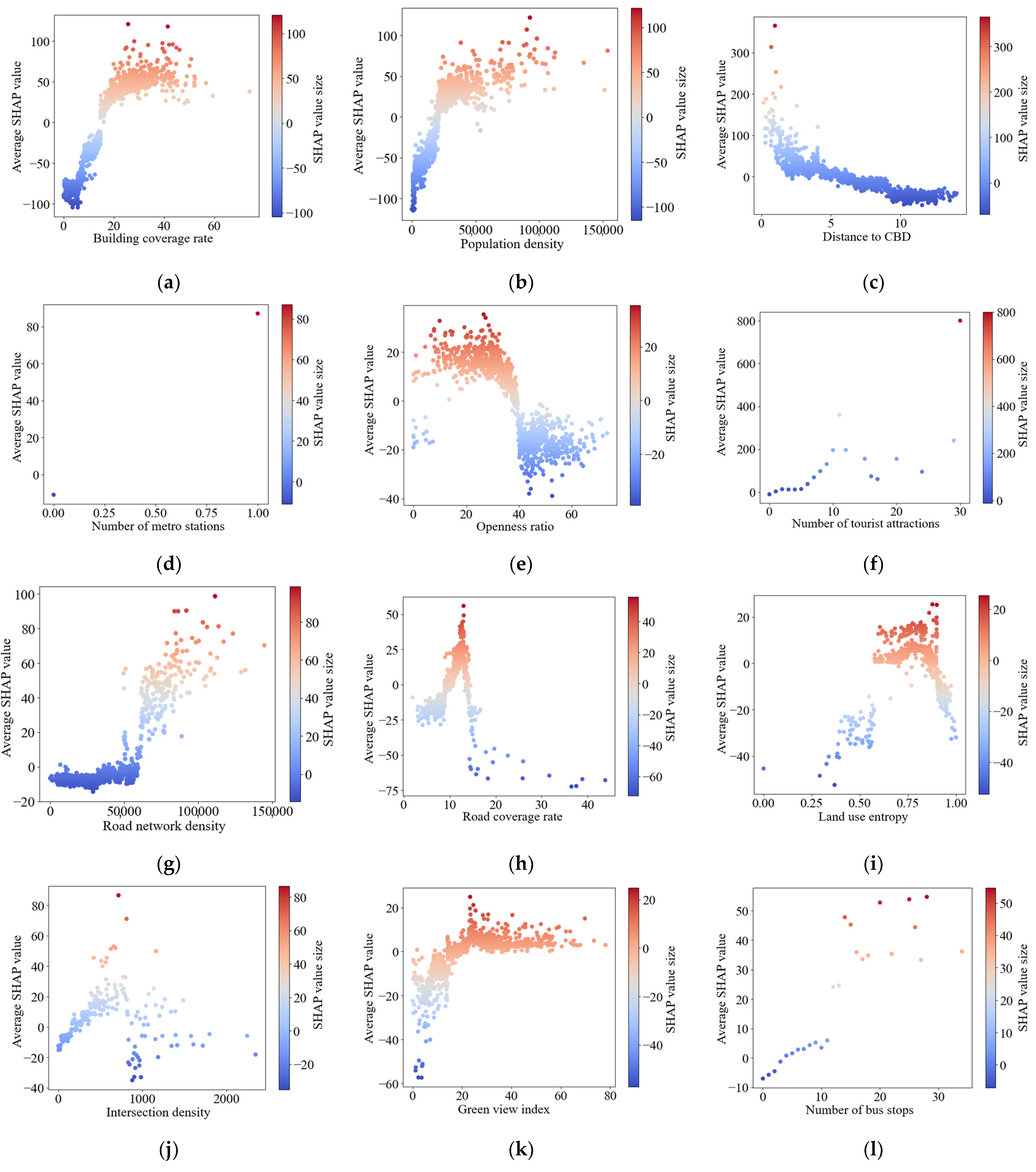Investigating the Nonlinear Relationship Between the Built Environment and Urban Vitality Based on Multi-Source Data and Interpretable Machine Learning
Abstract
:1. Introduction
2. Study Area and Data
2.1. Study Area
2.2. Data Source
2.3. Measurement of Urban Vitality (Dependent Variable)
2.4. Built Environment Elements (Independent Variables)
3. Methodology
3.1. Semantic Segmentation
3.2. XGBoost
3.3. Shapley Additive Explanations Model
4. Results
4.1. Model Performance
4.2. Relative Importance of Built Environment Elements
4.3. Nonlinear Association Analysis
5. Discussion
6. Conclusions
- (1)
- There is spatial heterogeneity in the distribution of urban vitality in Shanghai’s main urban area, with the high value of vitality distributed in Huangpu District and the surrounding intersections with various districts to the west, and the vitality exhibits a radial decay pattern emanating from central zones towards peripheral areas.
- (2)
- Compared to the GBDT and random forest models, the XGBoost model fits better and shows higher performance in simulating and predicting urban vitality.
- (3)
- Among all environmental elements affecting urban vitality in Shanghai’s main urban area, the top three in terms of relative importance are building coverage, population density, and distance to the CBD, which exert the most significant effects, while the green view index and the number of bus stops have a relatively low contribution to urban vitality. Building coverage has the largest positive effect on urban vitality, and distance to the CBD exhibits the largest negative correlation with urban vitality.
- (4)
- The study based on SHAP value analysis shows that each factor of the built environment has a nonlinear effect on urban vitality and presents a specific threshold value. The nonlinear and threshold effects of urban vitality offer a quantitative analysis tool for urban planning, facilitating one to reasonably allocate resources, especially the range of values of built environment factors that can better guide the optimization of spatial resources.
Author Contributions
Funding
Data Availability Statement
Conflicts of Interest
References
- Jacobs, J. The Death and Life of Great American Cities; Vintage: New York, NY, USA, 1961. [Google Scholar]
- Montgomery, J. Making a city: Urbanity, vitality and urban design. J. Urban Des. 1998, 3, 93–116. [Google Scholar] [CrossRef]
- Still, B.; Simmonds, D. Parking restraint policy and urban vitality. Transp. Rev. 2000, 20, 291–316. [Google Scholar] [CrossRef]
- Pan, J.; Zhu, X.; Zhang, X. Urban vitality measurement and influence mechanism detection in China. Int. J. Environ. Res. Public Health 2022, 20, 46. [Google Scholar] [CrossRef]
- Liu, Y.; Liu, X.; Gao, S.; Gong, L.; Kang, C.; Zhi, Y.; Shi, L. Social sensing: A new approach to understanding our socioeconomic environments. Ann. Assoc. Am. Geogr. 2015, 105, 512–530. [Google Scholar] [CrossRef]
- Talen, E.; Jeong, H. Does the classic American main street still exist? An exploratory look. J. Urban Des. 2019, 24, 78–98. [Google Scholar] [CrossRef]
- Lee, S.H.; Kang, J.E. Impact of particulate matter and urban spatial characteristics on urban vitality using spatio-temporal big data. Cities 2022, 131, 104030. [Google Scholar] [CrossRef]
- Cai, J.; Huang, B.; Song, Y. Using multi-source geospatial big data to identify the structure of polycentric cities. Remote Sens. Environ. 2017, 202, 210–221. [Google Scholar] [CrossRef]
- Wu, C.; Ye, X.; Ren, F.; Du, Q. Check-in behaviour and spatio-temporal vibrancy: An exploratory analysis in Shenzhen, China. Cities 2018, 77, 104–116. [Google Scholar] [CrossRef]
- Zhang, P.; Zhang, T.; Fukuda, H.; Ma, M. Evidence of multi-source data fusion on the relationship between the specific urban built environment and urban vitality in Shenzhen. Sustainability 2023, 15, 6869. [Google Scholar] [CrossRef]
- Ma, Z. Deep exploration of street view features for identifying urban vitality: A case study of Qingdao city. Int. J. Appl. Earth Obs. Geoinf. 2023, 123, 103476. [Google Scholar] [CrossRef]
- Kruse, J.; Kang, Y.; Liu, Y.N.; Zhang, F.; Gao, S. Places for play: Understanding human perception of playability in cities using street view images and deep learning. Comput. Environ. Urban Syst. 2021, 90, 101693. [Google Scholar] [CrossRef]
- Chen, C.; Wang, J.; Li, D.; Sun, X.; Zhang, J.; Yang, C.; Zhang, B. Unraveling nonlinear effects of environment features on green view index using multiple data sources and explainable machine learning. Sci. Rep. 2024, 14, 30189. [Google Scholar] [CrossRef] [PubMed]
- Ewing, R.; Cervero, R. Travel and the built environment: A meta-analysis. J. Am. Plan. Assoc. 2010, 76, 265–294. [Google Scholar] [CrossRef]
- Yang, J.; Cao, J.; Zhou, Y. Elaborating non-linear associations and synergies of subway access and land uses with urban vitality in Shenzhen. Transp. Res. Part A Policy Pract. 2021, 144, 74–88. [Google Scholar] [CrossRef]
- Yin, C.; Gui, C.; Wen, R.; Shao, C.; Wang, X. Exploring heterogeneous relationships between multiscale built environment and overweight in urbanizing China. Cities 2024, 152, 105156. [Google Scholar] [CrossRef]
- Lyu, G.; Angkawisittpan, N.; Fu, X.; Sonasang, S. Investigating the relationship between built environment and urban vitality using big data. Sci. Rep. 2025, 15, 579. [Google Scholar] [CrossRef]
- Yin, C.; Shao, C. Revisiting commuting, built environment and happiness: New evidence on a nonlinear relationship. Transp. Res. Part D Transp. Environ. 2021, 100, 103043. [Google Scholar] [CrossRef]
- Gao, M.; Fang, C. Deciphering urban cycling: Analyzing the nonlinear impact of street environments on cycling volume using crowdsourced tracker data and machine learning. J. Transp. Geogr. 2025, 124, 104179. [Google Scholar] [CrossRef]
- Yang, L.; Yang, H.; Yu, B.; Lu, Y.; Cui, J.; Lin, D. Exploring non-linear and synergistic effects of green spaces on active travel using crowdsourced data and interpretable machine learning. Travel Behav. Soc. 2024, 34, 100673. [Google Scholar] [CrossRef]
- Liu, Y.; Li, Y.; Yang, W.; Hu, J. Exploring nonlinear effects of built environment on jogging behavior using random forest. Appl. Geogr. 2023, 156, 102990. [Google Scholar] [CrossRef]
- Wang, X.; Yin, C.; Zhang, J.; Shao, C.; Wang, S. Nonlinear effects of residential and workplace built environment on car dependence. J. Transp. Geogr. 2021, 96, 103207. [Google Scholar] [CrossRef]
- Cervero, R.; Kockelman, K. Travel demand and the 3Ds: Density, diversity, and design. Transp. Res. Part D Transp. Environ. 1997, 2, 199–219. [Google Scholar] [CrossRef]
- Li, J.; Li, J.; Yuan, Y.; Li, G. Spatiotemporal distribution characteristics and mechanism analysis of urban population density: A case of Xi’an, Shaanxi, China. Cities 2019, 86, 62–70. [Google Scholar] [CrossRef]
- Tang, L.; Lin, Y.; Li, S.; Li, S.; Li, J.; Ren, F.; Wu, C. Exploring the influence of urban form on urban vibrancy in Shenzhen based on mobile phone data. Sustainability 2018, 10, 4565. [Google Scholar] [CrossRef]
- Zhang, X.; Sun, Y.; Chan, T.O.; Huang, Y.; Zheng, A.; Liu, Z. Exploring impact of surrounding service facilities on urban vibrancy using Tencent location-aware data: A case of Guangzhou. Sustainability 2021, 13, 444. [Google Scholar] [CrossRef]
- Li, X.; Li, Y.; Jia, T.; Zhou, L.; Hijazi, I.H. The six dimensions of built environment on urban vitality: Fusion evidence from multi-source data. Cities 2022, 121, 103482. [Google Scholar] [CrossRef]
- Sung, H.; Lee, S. Residential built environment and walking activity: Empirical evidence of Jane Jacobs’ urban vitality. Transp. Res. Part D Transp. Environ. 2015, 41, 318–329. [Google Scholar] [CrossRef]
- Ye, Y.; Li, D.; Liu, X. How block density and typology affect urban vitality: An exploratory analysis in Shenzhen, China. Urban Geogr. 2018, 39, 631–652. [Google Scholar] [CrossRef]
- Zhang, A.; Xia, C.; Chu, J.; Lin, J.; Li, W.; Wu, J. Portraying urban landscape: A quantitative analysis system applied in fifteen metropolises in China. Sustain. Cities Soc. 2019, 46, 101396. [Google Scholar] [CrossRef]
- Yang, Z.; Zhang, C.; Li, G.; Xu, H. Analysis of the impact of different road conditions on accident severity at highway-rail grade crossings based on explainable machine learning. Symmetry 2025, 17, 147. [Google Scholar] [CrossRef]
- Delclòs-Alió, X.; Gutiérrez, A.; Miralles-Guasch, C. The urban vitality conditions of Jane Jacobs in Barcelona: Residential and smartphone-based tracking measurements of the built environment in a Mediterranean metropolis. Cities 2019, 86, 220–228. [Google Scholar] [CrossRef]
- Ling, Z.; Zheng, X.; Chen, Y.; Qian, Q.; Zheng, Z.; Meng, X.; Shi, X. The nonlinear relationship and synergistic effects between built environment and urban vitality at the neighborhood scale: A case study of Guangzhou’s central urban area. Remote Sens. 2024, 16, 2826. [Google Scholar] [CrossRef]
- Yang, C.; Xu, F.; Jiang, L.; Wang, R.; Yin, L.; Zhao, M.; Zhang, X. Approach to quantify spatial comfort of urban roads based on street view images. J. Geo-Inf. Sci. 2021, 23, 785–801. [Google Scholar]
- Chen, L.C.; Zhu, Y.; Papandreou, G.; Schroff, F.; Adam, H. Encoder-decoder with atrous separable convolution for semantic image segmentation. In Proceedings of the European Conference on Computer Vision (ECCV), Munich, Germany, 8–14 September 2018; pp. 801–818. [Google Scholar]
- Zhang, L.; Wang, L.; Wu, J.; Li, P.; Dong, J.; Wang, T. Decoding urban green spaces: Deep learning and Google Street View measure greening structures. Urban For. Urban Green. 2023, 87, 128028. [Google Scholar] [CrossRef]
- Chen, T.; Guestrin, C. XGBoost: A scalable tree boosting system. In Proceedings of the 22nd ACM SIGKDD International Conference on Knowledge Discovery and Data Mining, San Francisco, CA, USA, 13–17 August 2016; pp. 785–794. [Google Scholar]
- Kuhn, H.W.; Tucker, A.W. (Eds.) Contributions to the Theory of Games; Princeton University Press: Princeton, NJ, USA, 1953; No. 28. [Google Scholar]
- Lundberg, S.M.; Lee, S.I. A unified approach to interpreting model predictions. Adv. Neural Inf. Process. Syst. 2017, 30, 4765–4774. [Google Scholar]
- Štrumbelj, E.; Kononenko, I. Explaining prediction models and individual predictions with feature contributions. Knowl. Inf. Syst. 2014, 41, 647–665. [Google Scholar] [CrossRef]
- Lundberg, S.M.; Erion, G.; Chen, H.; DeGrave, A.; Prutkin, J.M.; Nair, B.; Lee, S.I. From local explanations to global understanding with explainable AI for trees. Nat. Mach. Intell. 2020, 2, 56–67. [Google Scholar] [CrossRef]
- Molnar, C. Interpretable Machine Learning: A Guide for Making Black Box Models Explainable; Lulu.com: Raleigh, NC, USA, 2022. [Google Scholar]
- Jin, X.; Long, Y.; Sun, W.; Lu, Y.; Yang, X.; Tang, J. Evaluating cities’ vitality and identifying ghost cities in China with emerging geographical data. Cities 2017, 63, 98–109. [Google Scholar] [CrossRef]
- Tu, W.; Zhu, T.; Xia, J.; Zhou, Y.; Lai, Y.; Jiang, J.; Li, Q. Portraying the spatial dynamics of urban vibrancy using multisource urban big data. Comput. Environ. Urban Syst. 2020, 80, 101428. [Google Scholar] [CrossRef]
- Sun, B.; Ermagun, A.; Dan, B. Built environmental impacts on commuting mode choice and distance: Evidence from Shanghai. Transp. Res. Part D Transp. Environ. 2017, 52, 441–453. [Google Scholar] [CrossRef]





| Variables | Variable Description | Mean | S.D. | Min | Max |
|---|---|---|---|---|---|
| Urban vitality | Average Baidu Heat Index | 318.44 | 250.51 | 0 | 2419 |
| Micro variables | |||||
| Road coverage rate | Proportion of pixels occupied by roads in street view images | 10.11% | 2.91% | 1.93% | 43.82% |
| Building coverage rate | Proportion of pixels occupied by buildings in street view images | 19.01% | 10.56% | 0.04% | 74.02% |
| Green view index | Proportion of pixels occupied by green vegetation (e.g., trees, grass, shrubs, etc.) in street view images | 22.94% | 13.16% | 0 | 78.13% |
| Openness ratio | Proportion of pixels occupied by sky in street view images | 37.35% | 12.87% | 0.02 | 73.49% |
| Macro variables | |||||
| Population density | Number of people in the region/area of the region (person/km2) | 25,741.93 | 20,002.60 | 0 | 153,701.80 |
| Road network density | Road length/area size (m/km2) | 35,761.40 | 22,829.83 | 0 | 159,145.22 |
| Intersection density | Number of intersections/area size (counts/km2) | 245.19 | 273.21 | 0 | 2348.00 |
| Land-use entropy | , n is the number of POI types in the grid, and Pi is the percentage of POI type i in the grid | 0.81 | 0.16 | 0 | 1.00 |
| Number of tourist attractions | Number of tourist attractions in the region (counts) | 0.95 | 2.43 | 0 | 30.00 |
| Distance to CBD | Straight-line distance from grid center to nearest CBD (km) | 6.16 | 3.23 | 0.16 | 14.04 |
| Number of metro stations | Number of metro stations in the area (counts) | 0.10 | 0.30 | 0 | 2.00 |
| Number of bus stops | Number of bus stops in the area (counts) | 3.98 | 4.30 | 0 | 34.00 |
| Model Name | R2 | RMSE | MSE |
|---|---|---|---|
| GBDT | 0.315 | 185.699 | 34,484.40 |
| Random forest | 0.359 | 179.658 | 32,276.92 |
| XGBoost | 0.432 | 169.173 | 28,619.50 |
Disclaimer/Publisher’s Note: The statements, opinions and data contained in all publications are solely those of the individual author(s) and contributor(s) and not of MDPI and/or the editor(s). MDPI and/or the editor(s) disclaim responsibility for any injury to people or property resulting from any ideas, methods, instructions or products referred to in the content. |
© 2025 by the authors. Licensee MDPI, Basel, Switzerland. This article is an open access article distributed under the terms and conditions of the Creative Commons Attribution (CC BY) license (https://creativecommons.org/licenses/by/4.0/).
Share and Cite
Liu, W.; Yang, Z.; Gui, C.; Li, G.; Xu, H. Investigating the Nonlinear Relationship Between the Built Environment and Urban Vitality Based on Multi-Source Data and Interpretable Machine Learning. Buildings 2025, 15, 1414. https://doi.org/10.3390/buildings15091414
Liu W, Yang Z, Gui C, Li G, Xu H. Investigating the Nonlinear Relationship Between the Built Environment and Urban Vitality Based on Multi-Source Data and Interpretable Machine Learning. Buildings. 2025; 15(9):1414. https://doi.org/10.3390/buildings15091414
Chicago/Turabian StyleLiu, Wenhao, Zhen Yang, Chen Gui, Gen Li, and Hongyi Xu. 2025. "Investigating the Nonlinear Relationship Between the Built Environment and Urban Vitality Based on Multi-Source Data and Interpretable Machine Learning" Buildings 15, no. 9: 1414. https://doi.org/10.3390/buildings15091414
APA StyleLiu, W., Yang, Z., Gui, C., Li, G., & Xu, H. (2025). Investigating the Nonlinear Relationship Between the Built Environment and Urban Vitality Based on Multi-Source Data and Interpretable Machine Learning. Buildings, 15(9), 1414. https://doi.org/10.3390/buildings15091414







